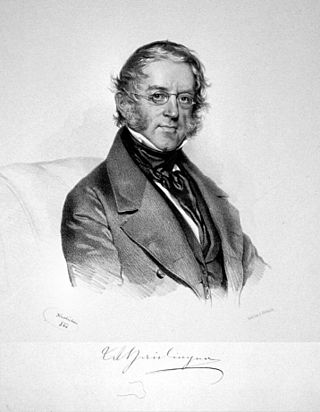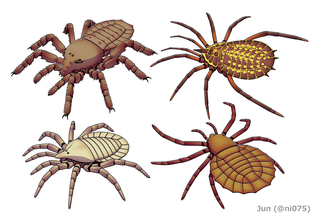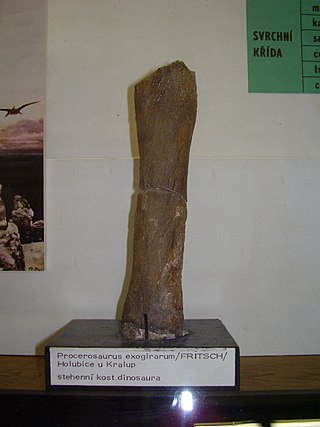
Wilhelm Karl Ritter von Haidinger was an Austrian mineralogist.
Albisaurus was once thought to be a genus of dinosaur, but is now thought to be a non-dinosaurian archosaur. It was first described by Antonin Fritsch, a Czech palaeontologist, in 1893, but the remains are sparse. The validity of the species cannot be proven based on the fossil remains, and it is usually marked as a nomen dubium. It lived during the Turonian-Santonian stages of the Cretaceous period.

The order Trigonotarbida is a group of extinct arachnids whose fossil record extends from the late Silurian to the early Permian. These animals are known from several localities in Europe and North America, as well as a single record from Argentina. Trigonotarbids can be envisaged as spider-like arachnids, but without silk-producing spinnerets. They ranged in size from a few millimetres to a few centimetres in body length and had segmented abdomens (opisthosoma), with the dorsal exoskeleton (tergites) across the backs of the animals' abdomens, which were characteristically divided into three or five separate plates. Probably living as predators on other arthropods, some later trigonotarbid species were quite heavily armoured and protected themselves with spines and tubercles. About seventy species are currently known, with most fossils originating from the Carboniferous coal measures.

Ponerosteus is a dubious genus of archosauromorph which was first identified as "Iguanodon exogirarum" by Antonín Frič in 1878 for a specimen from the Cenomanian. He later (1905) renamed it Procerosaurus, unaware that this name was already in use. It was renamed Ponerosteus exogyrarum by George Olshevsky in 2000; however, the taxon is considered a nomen dubium by most, as the type material is extremely poor, being apparently an internal cast of a tibia from an animal that may or may not be a dinosaur. The name Ponerosteus can be translated as "bad", "worthless", or "useless bone", which accurately describes the nature of the material.

Paul Gustav Samuel Stäckel was a German mathematician, active in the areas of differential geometry, number theory, and non-Euclidean geometry. In the area of prime number theory, he used the term twin prime for the first time.

The black bushbird is a species of insectivorous bird in the antbird family Thamnophilidae. It is monotypic within the genus Neoctantes. It is found in Brazil, Colombia, Ecuador, and Peru. Its natural habitat is subtropical or tropical moist lowland forests.

Cretornis is a pterosaur genus from the late Cretaceous period of what is now the Jizera Formation in the Czech Republic, dating to about 92 million years ago. It only contains a single species, Cretornis hlavaci.

Scanisaurus is a dubious genus of plesiosaur that lived in what is now Sweden and Russia during the Campanian stage of the Late Cretaceous period. The name Scanisaurus means "Skåne lizard", Skåne being the southernmost province of Sweden, where a majority of the fossils referred to the genus have been recovered. The genus contains one species, S. nazarowi, described in 1911 by Nikolay Bogolyubov as a species of Cimoliasaurus based on a single vertebral centrum discovered near Orenburg, Russia.
Paleontology or palaeontology is the study of prehistoric life forms on Earth through the examination of plant and animal fossils. This includes the study of body fossils, tracks (ichnites), burrows, cast-off parts, fossilised feces (coprolites), palynomorphs and chemical residues. Because humans have encountered fossils for millennia, paleontology has a long history both before and after becoming formalized as a science. This article records significant discoveries and events related to paleontology that occurred or were published in the year 1905.

Cheliderpeton is an extinct genus of temnospondyl amphibian. It lived during the Early Permian in what is now Europe. Fossils have been found from the Ruprechtice horizon of the Intrasudetic Basin of Bohemia in the Czech Republic, as well as the Saar-Nahe Basin of southwestern Germany. Cheliderpeton had a 16 cm skull, and reached about 65 cm in length.

Cimoliasaurus was a plesiosaur that lived during the Late Cretaceous (Maastrichtian) of New Jersey. It grew up to 7.5 metres (25 ft) long and weighed up to 1 metric ton.
Paleontology or palaeontology is the study of prehistoric life forms on Earth through the examination of plant and animal fossils. This includes the study of body fossils, tracks (ichnites), burrows, cast-off parts, fossilised feces (coprolites), palynomorphs and chemical residues. Because humans have encountered fossils for millennia, paleontology has a long history both before and after becoming formalized as a science. This article records significant discoveries and events related to paleontology that occurred or were published in the year 1884.

Moritz Allé (1837–1913) was an Austrian astronomer and mathematician, one of the teachers of Nikola Tesla.
Zoarces elongatus, also known as the eastern viviparous blenny is an eelpout in the family Zoarcidae, described by Rudolf Kner in 1868. The species is endemic to the Northwest Pacific, in such areas as the Sea of Japan and the Sea of Okhotsk and China.

Onchopristis is an extinct genus of sclerorhynchoid from the Cretaceous of North Africa, Europe, and North America. Its name is derived from the Ancient Greek ónkos and prístis. It contains two valid species, O. numida and O. dunklei. Onchopristis first appeared in the Barremian and its latest occurrence dates to the Campanian, making it one of the oldest and longest-lived sclerorhynchoid genera.
Viktor Litschauer was an Austrian mycologist.

Richard Henke was an Austrian chemist and inventor.
Prunus elaeagrifolia is a species of wild almond native to Iran. It is shrub or small tree 3-4 m tall, with the gray bark of its older twigs peeling in places and showing a brownish-yellow underbark. Its leaves are densely pubescent, with the pubescence yellowish gray. It is mostly found in the southern portion of the Zagros Mountains, where in places it is one of the dominant tree species. Its 2n=16 chromosomes have karyotypic formula 7m+t.

The Jizera Formation is a geologic unit of Late Cretaceous (Turonian) age, located in the Czech Republic. It is a unit of the Bohemian Cretaceous Basin. It consists of fluvial to shallow marine sediments and pterosaur fossils are among the remains found in the Jizera Formation. The type locality of the Jizera Formation is a quarry in Zářecká Lhota.
Hugo Zukal (1845–1900) was an Austrian lichenologist and mycologist. Born in Troppau, he graduated from high school there in 1859, and was afterwards employed as a botanist until 1864. From 1864 until 1872, he served in the Kaiserlich-Königlich army. After this, he attended the teacher training college in Trautenau, and became a teacher in Freudental and Vienna. He has been credited for having introduced the term pallisade hyphae in an 1895 publication to refer to a microscopic arrangement of fungal tissue characteristic of the cortex in the lichen genus Roccella. In 1898 he became a professor of phytopathology at the University of Natural Resources and Life Sciences, Vienna. He died in Vienna in 1900.












